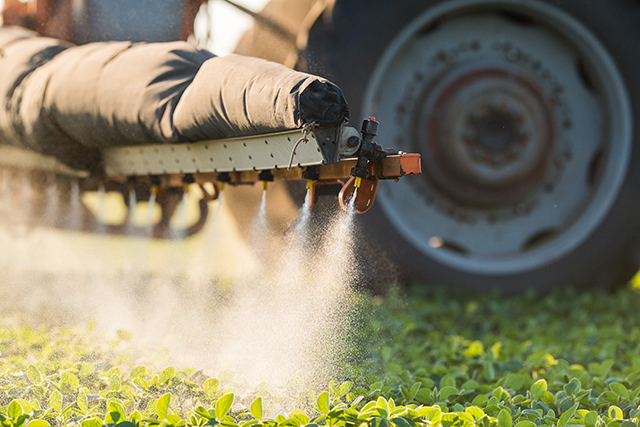Childhood cancer linked to environmental factors like pollution and solvents, warn researchers
10/13/2020 / By Zoey Sky

Cancer is a prevalent and devastating disease. But according to a report released last September, 90 percent of all childhood cancer cases are preventable — if only cancer charities and research organizations spent more resources on prevention.
A “less flashy” approach to cancer prevention
Several studies suggest that cancer is the leading cause of death from disease for children in America. However, in September, over 60 stakeholders and respected experts in the health, science, business, policy and advocacy sectors worked together to take a different, “less-flashy” approach to cancer prevention, specifically by ending the use of toxic chemicals linked to the disease.
Through the Childhood Cancer Prevention Initiative (CCPI), several organizations published a report that studied the impact of different cancer-causing chemicals on the health of children. The CCPI participants also called for a “national plan” to effectively address childhood cancer.
Devote more resources to childhood cancer prevention
Experts warn that in 2020, about 1,806,590 new cases of cancer will be diagnosed in America and that 606,520 people will die from the disease.
An estimated 16,850 children and adolescents will be diagnosed with cancer, while at least 1,730 children will die of the disease. Researchers say that only 10 percent of all childhood cancers come from hereditary factors, indicating that most cases of childhood cancers are linked to environmental factors.
To the CCPI, this means that 90 percent of all childhood cancer is preventable. Unfortunately, cancer charities and research organizations don’t devote enough resources to prevention.
In fact, the majority of childhood cancer research funding goes to studies on childhood cancer treatment and survivorship. This leaves only a small portion for studies on cancer prevention.
The chemicals associated with childhood cancer
The CCPI report identified three groups of chemicals, namely pesticides, traffic-related air pollution and paints and solvents, that are linked to common types of childhood cancer.
Pesticides
Exposure to pesticides or chemicals used to control the growth of insects (insecticides), weeds (herbicides) and fungi (fungicides) in farms and at home is a known risk factor for leukemia, brain cancer and childhood lymphomas.
Residential pesticide exposure
Data suggests that early exposure to pesticides used at home is linked to an increased risk of leukemia and brain tumors, along with an increased risk of childhood lymphomas. While both insecticides and herbicides were linked to these conditions, risks were greater for those exposed to insecticides indoors.
Compared to controls, an increased risk of childhood leukemia was also observed in children born to mothers exposed either before conception or during pregnancy, as well as in children exposed after birth.
For brain cancer, risks were greater for children born to mothers exposed during pregnancy and children whose fathers were exposed prior to conception. For lymphoma, risks were increased for children with mothers exposed during pregnancy.
Worryingly, the World Health Organization’s International Agency for Research on Cancer (IARC) has listed several Environmental Protection Agency (EPA)-approved pesticides as either known, probable or possible carcinogens, including glyphosate.
Traffic-related air pollution
Some studies have also looked into the effects of chemical contaminants released in the exhaust of motorized vehicles and their potential links to childhood cancers.
The IARC has classified several air pollutants as known, probable or possible human carcinogens. Some of them, such as 1,3-butadiene, benzene and formaldehyde, are known causes of leukemia in adults.
Data suggests that traffic-related air pollution is also strongly linked to childhood leukemia. According to independently conducted meta-analyses, the risk of childhood leukemia is greater for children exposed to traffic-related air pollution. (Related: Prolonged exposure to air pollution triggers inflammation, appearance of cancer-related genes.)
Paints and solvents
Paints and solvents used at home or in the workplace have also been the focus of studies on childhood cancer. These chemicals were primarily investigated in relation to the risk of childhood leukemia.
Paints
A pooled analysis of case-control studies suggests that home paint exposure shortly before conception (one to three months), during pregnancy and after birth increases the risk of childhood leukemia.
The IARC has also found a link between maternal exposure, both preconception and during pregnancy, and an increased risk of childhood leukemia.
Solvents
Benzene is a known cause of adult leukemia, especially acute myeloid leukemia (AML). Benzene exposure among children has also been reported and has inspired researchers to study the relationship between this particular organic solvent and the risk of childhood leukemia.
Several studies have found that maternal occupational exposure to benzene during pregnancy may also be harmful. Although parental exposure to other types of solvents is not that well-studied, early findings from cases of childhood leukemia in Woburn, Massachusetts suggest that there are links between childhood leukemia and chlorinated solvents. In fact, the risk was found to be eight times higher in children whose mothers had ingested contaminated water while pregnant.
Children who live near industrial manufacturing, agricultural facilities, major transportation routes or hazardous waste sites are also at greater risk for chronic diseases.
Help “all children to thrive,” urged the CCPI
The CCPI urged for continued research into the more than 85,000 manufactured chemicals currently used in the United States. Despite being approved for use, many of these chemicals contribute to cancer development.
And since most of these chemicals have never been tested for safety or toxicity, there is no verified list of chemicals that may cause cancer in children. The CCPI thus urged the private sector and the government to work together for a common goal: To help all children to thrive.
The authors of the report also emphasized the need to end the production of these harmful chemicals and products.
Some examples of cancer-causing chemicals include Lumber Liquidators, which saw a 25 percent decline in value after findings revealed the company was selling flooring with formaldehyde. Bayer’s stock value also fell 44 percent after a lawsuit revealed that Roundup, its glyphosate-based weed killer, is a known carcinogen.
The authors warned that businesses that avoid making changes to their business models risk millions in legal fees from consumer lawsuits. They could also suffer bigger financial losses if an accident occurs involving chemicals that harm employees and shoppers.
The CCPI said companies that produce and use dangerous chemicals and emissions aren’t only the problem, they may also be potential sources for solutions.
Policymakers can also help by placing stricter limits on the level of pesticides in food and the level of human exposure to possible environmental factors. The CCPI suggests that U.S. legislators protect environmental regulatory programs that are “under attack” by restoring policies that protect communities of color and low-income neighborhoods since they are often harmed by polluting activities.
The CCPI noted that investing into a new economy without chemicals, products and technologies that contribute to cancer is key to preventing childhood cancers.
The CCPI also hopes that their detailed report can serve as the first step toward cementing the commitment of the 12 organizations involved in ending the production of cancer-inducing chemicals and finding safer alternatives to ensure the health of children across the country.
Sources include:
Submit a correction >>
Tagged Under:
carcinogens, CCPI, childhood cancer, childhood leukemia, children's health, environment, glyphosate, research, toxic chemicals, toxins
This article may contain statements that reflect the opinion of the author
RECENT NEWS & ARTICLES
Chemicals.News is a fact-based public education website published by Chemicals News Features, LLC.
All content copyright © 2018 by Chemicals News Features, LLC.
Contact Us with Tips or Corrections
All trademarks, registered trademarks and servicemarks mentioned on this site are the property of their respective owners.





















